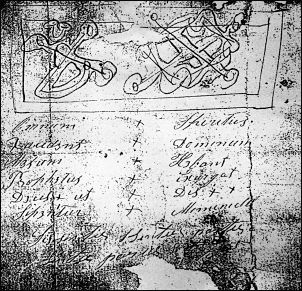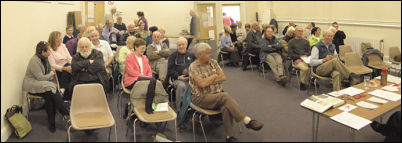|
|
|
Oct 2009 |
|
|
|
Mon 19 Oct 2009
Back to School - St James’s Church of England Primary School,
Chorley |
|
Back to School
In early September the Society received an approach from Andrew
Clarke. Andrew is Deputy Head Master at St James’s Church of
England Primary School, Chorley.
Andrew wanted the pupils to learn and appreciate more of
Chorley’s history. In support of his aim he looked to the
‘experts’. Following discussions between Andrew and Joan
Dickinson, Monday 19 October was set for some Society member to
go ‘back to school’.
Joan was accompanied by husband Kevin, Mike and Sandra Berry,
John and Christine Harrison, Peter Robinson and Stuart Whalley.
Special thanks to Stuart who brought along part of his
archaeological finds, including coins, bottles, flint and stone
grinder. |

The team |
|

Stuart's table of goodies |
The sound of
Wagner’s ‘Ride of the Valkyries’ dramatically announced the
arrival of teachers and pupils into the gym. About 80 pupils
aged between 8 and 11 then sat on the floor in rows facing the
Society’s panel.
Brief introductions by Andrew and Joan were then followed by
Mike. Mike explained of his connections with St James’. An uncle
had been the Head Master in 1960’s and a friend, Mr Norcross,
had been Head Master for 17 years.
Mike had had chance to see the Head Master’s Log and gave
snippets of information from St James’s history. He explained
that the neighbouring, soon to be demolished, old school was
opened on 11 January 1873. An entertaining and interesting
potted history of St James’ intervening 136 years was given.
Responses were invited frequently and the pupils eagerly
replied. |
|
Andrew then
invited pupils to question the panel on their knowledge of
Chorley’s history. And there was no shortage of questioners.
First one was, ‘when was Chorley found? ‘ John handled this one
with confidence. A series of well thought out and objective
questions followed, which included, ‘what was Astley Hall like?’
Sandra dealt with this with aplomb. Similarly, the panel dealt
well with everything thrown at them.
To conclude, all the pupils had the opportunity to view at close
hand Stuart’s archaeological finds, which they took with relish.
Before we knew it school was finished for the day.
By all accounts it was a different outing for the Society but
one which was enjoyed by the members, teachers and, of course,
pupils.
text by Peter Robinson & thanks
to Joan for the images. |

Stuart's table of goodies |
|
|
Fri 16 Oct 2009
John Hallam: Archaeologist |
At the October 2009 meeting of
our Society, Peter Robinson reported the death of John Hallam,
Archaeologist. I was reminded that his book “The Surviving Past”
was the best piece of research and writing that has been
published on archaeological finds and excavations in our part of
Lancashire. I cannot find a precise date for the book but it
seems to be late 1970s/early 1980s. (It must be long out of
print; I picked up my copy second hand a few years ago).
The cover of “The Surviving Past” gives information on John
Hallam’s life up to the point of publishing. He was born in
Accrington, went to Manchester University and later held a
Leverhulme Research Fellowship at Liverpool University,
specialising in the pre-history of Lancashire and the
North-West. He had directed many excavations in the County the
most notable being the hunted, but not captured, prehistoric elk
at Poulton-le-Fylde. He became consultant archaeologist to the
Central Lancashire New Town in 1975.
The book is the summation of archaeological surveys and
excavations carried out over a 10 year period for the Central
Lancashire Development Corporation. (A name which has itself
been history for many years!) The introduction suggests that the
book can be used as a guide book to not just sites, but also to
the historical features that surround us.
I leave you to discover the book at the library but just to whet
your appetite there are the following sections: |
Prehistory (including aboriginals,
early settlers, herders and traders and bronze age burial site)
Roman (including sites and finds and Roman Roads)
Anglo-Saxon and Viking (including the Cuerdale Hoard and
Settlements and Place Name Evidence)
Norman Conquest to the Industrial Revolution (including Castles,
Moated homesteads, Parish Churches and Religious House, Timber
Framed and Early Brick Buildings, Crosses and Wells)
The Nineteenth Century and Industrial Archaeology (including the
Lancaster Canal Tramway, Linen Weaving, Early Textiles and
Birkacre.) |
|
The layout makes
all the information easy to access and read, particularly as it
is accompanied by some excellent site plans.
John Harrison
October 16th 2009 |
|
|
Tue 13 Oct 2009
Peter Watson – North Country Folklore |
|
A good-sized
audience turned up to hear what Peter had in store with his
folklore tales.
They were not disappointed as from the start he engaged those
present with numerous questions. He opened with ‘what folklore
meant’ to them. Responses came thick and fast in the form of
witches, fairies, ghosts, boggarts, amongst others. |

Peter Watson |
|

A Witch Bottle |
Peter
stated that Lancashire folklore was the richest in
Britain. He went onto explain why this time of year,
particularly 1st November, All Saints Day, was so
important to the Celts.
Many strongly believed in superstitions to the extent
that certain people, such as witches, had the power to
control other peoples’ lives. These superstitions
survived through time. The village of Newchurch-in-Pendle
is said today to have 40 witches covens.
Peter explained that red is regarded as a magic colour
and believers feel it has the power to ward off evil.
Evidenced throughout history and across cultures.
He produced a ‘witch bottle’. It would contain material
cut in the shape of a heart and coloured red, a lock of
a witch’s hair and a written charm. Its use was as a
counter charm against witches who may have made a spell
against you. Peter offered it to anyone who may have the
need to use it. Nobody took up his offer. |
|
|
He produced
other items too that were believed to ward off evil. These
included rowan tree wood crosses, naturally holed stones, evil
eye and honesty seeds. Each item had a story woven around it,
which was rooted in northern England.
Peter concluded a fascinating evening by fielding a variety of
questions. One such was. ‘how do you sleep at night?’ No
problem, he replied. Did we believe him? Like much else said
that evening it’ll remain a mystery.
Peter Robinson |

Strange signs and names found in
and old house near Pendle. |
|

A good-sized audience turned up |
|
|
Tue 13 Oct 2009
Press launch for the revamped and
upgraded History leaflet for Yarrow Valley Park |
|
This
afternoon, 13th October, 2009. was the press launch for
the revamped and upgraded History leaflet for Yarrow
Valley Park. This has been accomplished over the past 12
months or so, with the help of Sarah at Y.V.P. along
with some of our members. The finished article is full
of information regarding the history of Birkacre along
with a colourful numbered map of the area picked up also
with pictures and information relating to the numbers on
the map. It has been produced by Chorley Borough Council
via a grant. It is a great improvement on the previous
black and white leaflet, and I am sure it will be very
visitor and child friendly. Some of our members were at
the launch, and the leaflets should now be out and about
in Chorley.
Joan Dickinson |
 |
|
 |
|
|
|
Tue 13 Oct 2009
Hygienic Laundry (Pennine Cleaners)
re-union. |
|
This afternoon
I attended a re-union of people who use to work at the Hygienic
Laundry (Pennine Cleaners) in Chorley which was closed in 2007.
The event was held at the Malthouse, Moss Lane,
Whittle-le-Woods. The event was organised by one of he retired
managers, Mr Bertrand Potts, and he should be congratulated on
the splendid job he did organising the event. Around 25 people turned up
and Bertrand had put up several displays of photographs of
memorabilia. It was fascinating for me to see some of the
earliest photographs from around 1907 when the business
commenced.
B Harris |

A float in the annual trades procession 1908 |
|

The delivery fleet in 1910 by the original building |
|

The enlarged works in 1915. Note the state of the road |
|
 |
|

The re-union pose for a group photo. Bertrand Potts is seated
front centre |
|
|
12 Oct 2009
A full set of 'The Flat iron'
publications are now available on this website.
They were published from issue no.1 in 1987 to issue no.17 in
1999.
There are almost 490 pages of articles so the pdf file is quite
large at30Mg. |
 |
|
|
|
|
|